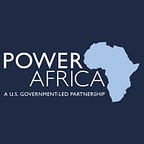A Day in the Dark
Exploring life in Africa without access to electricity
TWO OUT OF EVERY THREE SUB-SAHARAN AFRICANS LIVE WITHOUT POWER
That’s 600 million people who go through life without:
…A stove to cook on.
…Light to study with.
… Power lines to hospitals.
…Well-lit roads.
When President Obama launched Power Africa, we started thinking a lot about what a day in the “dark” would look like. We spent a full day on the outskirts of Nairobi to see for ourselves what life without electricity means and how it impacts the lives of the people we met.
Here’s our photo diary from sunrise to sunset.
DAY BREAK
In many parts of Sub-Saharan Africa, commuters start their day on foot, and often in the dark.
Students leave their homes before the sun rises to make it to class before the bell rings.
But in many cities, this means dangerous roads, unsafe neighborhoods and serious risks.
READING IN THE DARK
At school, we found that students often learn in dark classrooms and struggle to read their books. At home, they study by the light of paraffin candles or solar lamps.
Even our eyes had trouble adjusting to the light in these rooms.
But that doesn’t stop them from dreaming big.
For every student we talked to, school was the highlight of their day.
We asked Christine what she wanted to be what she grew up. She arrives to school each day before the sun rises to beat the other students.
“Since I was young, my dream has been to become a pilot and study hard.”
SAVING A LIFE
Hospitals and clinics were no different.
Nurses and doctors also operate in the dark. Patients get sick at all hours, and giving birth can suddenly become a complex and dangerous affair.
Vaccines cannot be refrigerated, costing thousands of people simple and life-saving medication.
A NURSE WITHOUT POWER
Faith works as a nurse in a health clinic that is not wired to electricity.
The nearest power line is 50 kilometers away, and roads leading to the clinic are unpaved and unsafe. Thanks to the generosity of donors, the clinic has all the right equipment.
“We have an oxygen machine, and x-ray machine, and an ultrasound machine. But none of them can be used without power. When we have an emergency we cannot attend to the patients,” she tells us.
“If we had electricity we would be able to do so many things.”
DOORS, UNOPENED
When your business can only run during the day, your output is severely impacted. Factories shut down during blackouts, markets can only operate while the sun is shining, and heat often creates less than desirable working situations.
For most of the world, electricity allows businesses to flourish, clinics to store vaccines, and students to study long after dark.
But for more than 600 million people in Africa, these opportunities simply do not exist — ultimately stifling growth.
NIGHT GAMES
In the evenings, when light is scarce, children and adults find ways to entertain themselves.
We found that this solar-powered soccer field was a crowd-builder and attracted both soccer games and fire games.
WIRED
In the midst of this hardship, people create their own solutions. Mothers, students, shop keepers, young innovators, and entrepreneurs across the continent are creating their own solutions to fill the energy gaps.
POWERING AFRICA
Power Africa is a partnership among the U.S. Government, African governments, bilateral and multilateral development partners, and the private sector to double access to electricity in sub-Saharan Africa. Power Africa’s goals are to increase electricity access by adding more than 30,000 megawatts of cleaner, more efficient electricity generation capacity and 60 million new home and business connections.
But most importantly, Power Africa provides the opportunity for Africans to direct their own development and growth.
With local communities and African leaders, Power Africa focuses on building a long-term partnership with Africa — creating the space for Africans and Americans to work together for the future of the continent.
“In partnership with African nations, we’re going to develop new sources of energy. We’ll reach more households not just in cities, but in villages and on farms. We’ll expand access for those who live currently off the power grid. And we’ll support clean energy to protect our planet and combat climate change. So, a light where currently there is darkness; the energy needed to lift people out of poverty — that’s what opportunity looks like.”
President Barack Obama
THE FUTURE OF AFRICA
We don’t have all the solutions ourselves.
But we are building a unique partnership model that can carve pathways for energy innovations.
It can brighten the future for hundreds of millions who live without electricity and everything it enables.
Together, we can translate human ingenuity into energy that drives economic growth in Africa and beyond.
Photos and text by Rudy Gharib, Power Africa Director of Communications
A version of this story originally appeared on USAID’s Exposure page on March 18, 2014
